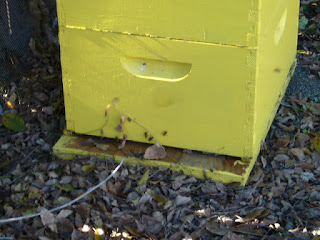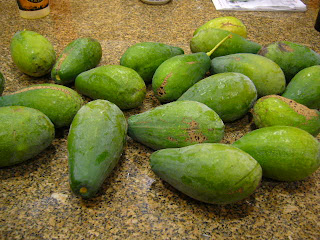 |
| Trimmed Tree Roses: Bird Back 40 |
When the lure of the yard becomes too much -- even in cold weather -- you know that one is progressing nicely from gall bladder removal surgery. After the first week at home after surgery? I couldn't even look at the yard. Now? A month and a half later? I can't wait to get out in the mud with a pair of chompers!
Now, that's progress!
It's that time of year again where we must say "goodnight" to the many tree and rose bushes that grace the Bird Back 40. This is always been a rather tough job for me because these roses have provided the wife that is Venus with multiple vases of flowers during the spring and summer months. A vase of home grown roses earns "points." Purchasing said roses does not. Remember this lesson boys: Grow Your Own.
 |
| Pruned St. Patrick's Tree Rose |
Now -- before we go any further here -- let me issue this warning. I am not a professional Rosarian. I am a professional screwup -- but we'll save that post for another day. My "experience" with trimming rose bushes comes from watching others do it, plus a few online tips and tricks. There are going to be some experienced folks (Fred) who will shudder at the sight of this whack job, but I can tell you this much.
I've come to learn that it really doesn't matter HOW I cut these roses back. What matters is that I DO cut them back. After three or four years of solid growth, the roses have always jumped back to life in the spring. And some, like the Stinkin Lincoln (aka Mister Lincoln), are now large enough to grow right over the fence line and keep right on growing.
 |
| Mister Lincoln in Winter |
By the way, does anyone know why the favorite known as Mister Lincoln is sometimes referred to as the Stinkin Lincoln? The answer is at the bottom -- but if you've already guessed -- I'm sorry but you don't win a prize. You have earned my respect, however. But, again, this is no prize.
There are two basic things that I keep in mind when trimming a rose bush. The first is locating and identifying the strongest and largest of the newest "canes" that developed during the previous spring and summer. The second thing that I watch out for is trimming said bush so it doesn't grow out and block off a walkway, as some of them have in recent years. This doesn't always result in a perfect, round cut. But my madness works in other ways.
Trust me, this is a madness.
 |
| Fat Purple Cane: Save Him! |
This purple colored cane on the Mister Lincoln is exactly the kind of growth that I'm looking to preserve. Older canes are black and somewhat woody and easy to distinguish from the newer canes that emerged earlier this year. This happens to be one of the nicest, fattest canes that emerged from the Mister Lincoln this year. This is a cane that I will want to preserve for newer growth that will emerge next spring.
Another plus: The cane is growing in a direction next to the fence line. Roses against fence lines make for the perfect show. Roses growing out and covering a sidewalk can be problematic, especially if the rose has thorns. And the Mister Lincoln has thorns. They are big, FAT thorns that tend to rip and shred clothing and skin if you're not careful. This isn't something you want growing into a walkway that was installed the previous spring.
Unlike previous years, when I didn't have to worry about sidewalk protection, I would keep and preserve the strongest canes no matter which direction they grew in. I can't do that anymore. So -- any cane jutting out near a walkway, no matter how nice or strong, gets pruned back completely. Harsh? Mebbe. But a rose bush like the Stinkin Lincoln will eventually get the message and grow in areas you want growth to occur in.
 |
| A "Must Have" When Trimming Rose Bushes |
The number one rule to remember when cutting back roses is this: Wear gloves. Wear heavy gloves. Wear gloves heavy enough to protect your hands against thorn abuse because no matter how careful you are, you're going to get nicked and pricked. The second rule to remember? Carry Bactine. Carry lots of Bactine and maybe a Hello Kitty brand First Aid kit.
Unlike previous years, I can no longer fit cuttings from eight rose and tree rose bushes into one green waste can, no matter now many small pieces I chomp the cuttings into or how much I jump up and down on the green waste can. It just doesn't work anymore. The rose bushes that Venus and I transferred over from the old North Natomas spread five years ago are now firmly established. And all of them have responded with so much growth that it usually takes two packing sessions and two days of cutting before the job of a winter nap is done.
 |
| No More Room at The Inn! |
Another important step to remember is removing leaves from around the base of a freshly whacked rose bush. This isn't always easy (remember: THORNS). However, this job can be accomplished with a strong broom or a blast from a blower. Removing leaves means non-beneficial bugs don't have a place to overwinter and gives new spring shoots a chance to grow unimpeded.
Finally? The hardest part about cutting back a rose bush? It's not the thorns, as I may have led you to believe. It's not the job of chomping canes into small bits so one can pack a green waste can. No -- the hardest part of cutting back a rose bush is cutting back a rose bush that has been placed next to a yellow beehive. Make that an "active" yellow beehive.
 |
| Curious Bees |
This is actually a nice sign if you're into the business of keeping bees as a hobby. An active beehive in late December means the colony inside that yellow colored hive has survived the summer and fall months and is overwintering well. It means there is a strong queen somewhere inside that yellow box. And it brings the promise of swarms in the spring for additional hives and honey production next year.
Yes, it does also mean you get the occasional visit from a curious bee or five. But I've come to find out that if you don't bother them, most of the time, they won't bother you.
 |
| Mister Lincoln Rose Bush |
MISTER LINCOLN: Introduced by Swim and Weeks in 1964, the Mister Lincoln is one of the most enduring red hybrid tea roses ever developed. While other red roses have come and gone, the Mister Lincoln has endured the test of time and is a favorite of many growers. It is also the most fragrant of all hybrid tea (long-stemmed) roses, earning it the well-deserved nickname of "Stinkin Lincoln."






































